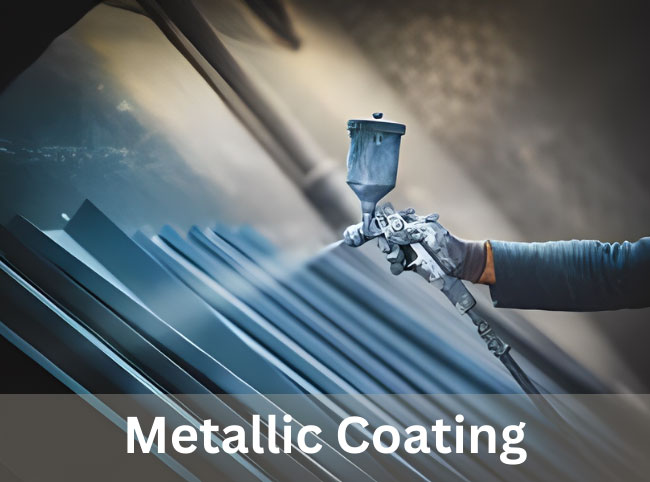
Metallic Coating Types, Uses and Benefits
Objects or materials which are prone to corrosion and reactions require a protective coating that can keep the original surface from any untoward effects. Such coatings are of many types, one of which is the most popularly utilized metallic type.
Protective coating for metal consist of metallic elements or metal alloys with the purpose of application onto the metal surfaces through various means. Such an application aims to provide a complete cover of protection from oxidation, corrosion, and sunlight while delivering a glossy appearance.
Anti rust coating for metal protect the surfaces against external elements such as environmental factors through modification of surface properties. Depending on the utility, there can be many metallic coating types to choose from.
Types of Metallic Coatings
There are 5 types of metal coatings to consider when the protection of a surface is in question.
1. Anodizing
This technique is used to provide a protective oxide coating on the surface. Usually, an oxidation process is similar to corrosion. But to prevent actual corrosion, a chemically established oxide layer is thicker and stronger, inhibiting organic corrosion. This is easier to maintain, clean, and protect. Aluminum is one of the fastest metals responding to this process while non-ferrous metals are immune to it. Therefore, electroplating anodizing is one of the best solutions limited to some types of metal surfaces only.
2. Galvanizing (zinc coating)
When the material made of steel or iron is dipped and submerged in a bath of molten zinc, the process is called galvanizing. A Zinc Carbonate layer is formed on the surface when the dipped metal reacts with environmental elements. The layer is a type of corrosion that is absorbed by the zinc metal coating to prevent the surface from being harmed. This layer is thick and strong, durable, and stuck to the surface securely by zinc plating.
3. Electroplating
This is a method where two metals are dipped and submerged in an electrolyte solution. One metal acts as a cathode while another as an anode. When electricity is passed through the solution, the ions from the anode stick to the cathode coating it securely. This kind of process forms a non-penetrable barrier while also modifying the properties of the original metal surface.
4. Powder coating
As the name suggests, this is a type of coating made possible through electronically charged metal powder particles to the opposite of the surface charge. When in the vicinity, opposites attract and the powder is coated firmly on the surface. Heating the coated surface makes the layer even firmer.
5. Paint coating
One of the most economical and easiest methods of coating is paint coating or liquid metal paint. Taking up any suitable paint to cover up the surface ensures a suitable level of protection.
There are various types of metallic coatings and each has some benefits to contribute.
Benefits of Metal Coatings
Benefits of metal coatings include:
1. Overall Protection
The purpose and the reason why metallic coatings are brought to the forefront are the benefits of complete protection they provide. With the covering, you can be relieved from corrosion difficulties in various metals and materials in industries.
2. Durability
A new barrier between the surface and external elements in the industry ensures that the damage to the surface is minimal during any wear and tear. This prolongs and life of the product and makes it more durable.
3. Aesthetics
Depending on the purpose and industry where the anti rust coating for metal are necessitated, aesthetics might be a good factor to consider. Choosing the type of metal coating that keeps the aesthetics up to par or even improves might be a great option that maintains the looks while protecting.
4. Greater performance
Using protective coating for metal adds to the performance of materials used in electronic equipment to enhance the electrical properties and conductivity. The most commonly considered application industry for this is the Automobile industry.
5. Cost Effectiveness
Metallic coatings as a way for protection are highly cost-effective. These improve the quality, add to aesthetics, reduce effort to protection, add to durability, enhance performance, and reduce maintenance costs.
Conclusion
Therefore, metallic coatings are one of the most beneficial methods of corrosion prevention for before, in-process, and after-manufacturing materials in the industry. No matter for a short duration, or extended, based on the appropriate choice of type of anti rust coating for metal, it is possible to maintain the materials, machinery, and equipment for a long time. Zavenir Daubert has a range of anti rust coating for metal to protect equipment and other industrial materials.
FAQ
What are the types of metallic coatings?
Metallic coatings include galvanization (zinc layer), electroplating (electrodeposition), metallic paints (containing metal particles), and anodizing (forming oxide layer).
What is metallic coat?
A metallic coat is a protective or decorative layer of metal applied to a surface, enhancing durability, preventing corrosion, or adding aesthetic appeal.
What is the process of metallic coating?
The process involves surface preparation, application (e.g., dipping, spraying, electroplating), curing or drying, and quality control inspection.
How many types of coating are there?
There are numerous coating types, including polymeric (paint, varnish), ceramic (heat-resistant), organic (natural sources), inorganic (metallic, ceramic), and electrochemical (anodizing, electroplating).

